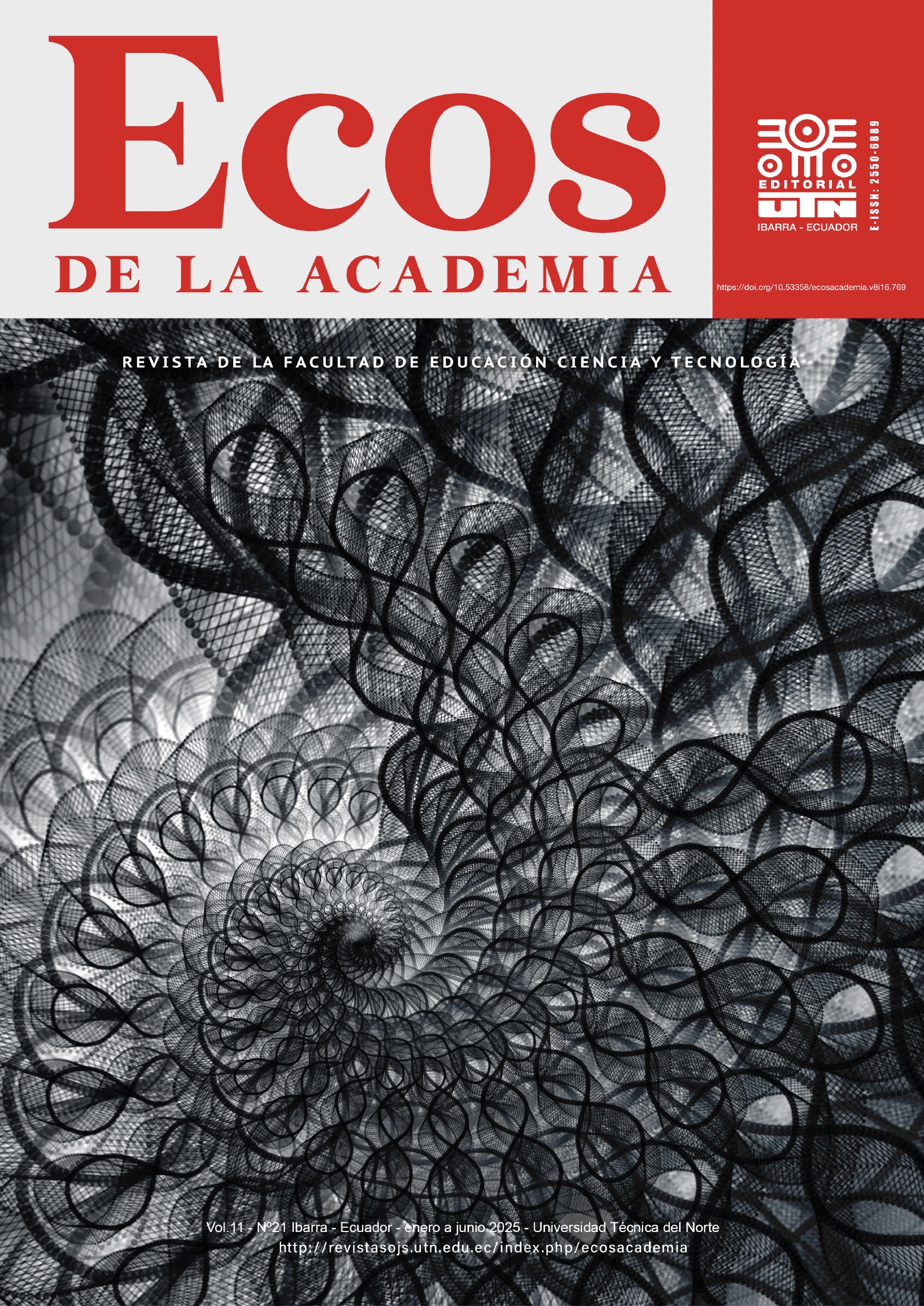Interactive Material for the Acquisition of the Alphabetic Code in Second Grade Primary School
Main Article Content
Abstract
The COVID-19 pandemic profoundly transformed educational processes, positioning Information and Communication Technologies (ICTs) as essential tools for ensuring the continuity of learning in emergency contexts. However, this transition revealed significant weaknesses in the development of literacy skills, particularly among second-grade students in primary school—a critical stage for the acquisition of the alphabetic code. In response to this situation, the present study aimed to analyze the interactive resources used for the literacy development, with a specific focus on the acquisition of the alphabetic code, among students at the “Otavalo Valle del Amanecer” Primary School during the 2023–2024 academic year. Methodologically, a quantitative approach with a descriptive design was employed, using surveys administered to teachers and legal guardians to identify needs and perceptions regarding the initial literacy process. The results revealed a high demand for supplementary resources to strengthen the teaching of the alphabetic code. The study concludes that the use of interactive digital materials constitutes an effective and necessary pedagogical strategy in this educational context to support literacy development in hybrid or virtual learning environments.
Downloads
Article Details

This work is licensed under a Creative Commons Attribution-NonCommercial-ShareAlike 4.0 International License.
The authors transfer the publication rights to the journal in all its formats and digital media.
Regarding Copyright CC BY-NC-SA 4.0, this journal is under a license of https://creativecommons.org/licenses/by-nc-sa/4.0/.
You are free to:
Share: copy and redistribute the material in any medium or format
Adapt: remix, transform, and build upon the material
The licensor cannot revoke these freedoms as long as you follow the license terms.
Under the following terms:
1. Attribution: You must give appropriate credit, provide a link to the license, and indicate if changes were made. You may do so in any reasonable manner, but not in any way that suggests the licensor endorses you or your use.
2.Non-Commercial:You may not use the material for commercial purposes.
3. ShareAlike: If you remix, transform, or build upon the material, you must distribute your contributions under the same license as the original.
4.No additional restrictions: You may not apply legal terms or technological measures that legally restrict others from doing anything the license permits.
Notices:
You do not have to comply with the license for elements of the material in the public domain or when your use is permitted by an applicable exception or limitation.
No warranties are given. The license may not grant you all the permissions necessary for your intended use. For example, other rights such as publicity, privacy, or moral rights may limit how you use the material.
LEGAL CODE CC BY-NC-SA 4.0
References
Alegría, J., Carrillo, M., & Sánchez, E. (2005). La enseñanza de la lectura. Investigación y ciencia, 340(1), 6-14
Arrebola, C. (2018). El aprendizaje ubicuo en la educación superior: el dónde y cuándo del aprendizaje. Publicaciones Didácticas, 99(18), 135-612. https://doi.org/10.47189/rcct.v18i18.183 DOI: https://doi.org/10.47189/rcct.v18i18.183
Cabero Almenara, J., & Llorente Cejudo, M. del C. (2015). Tecnologías de la Información y la Comunicación(TIC): escenarios formativos y teorías del aprendizaje. Revista Lasallista de Investigacion, 12(2), 186-193. https://doi.org/10.22507/rli.v12n2a19 DOI: https://doi.org/10.22507/rli.v12n2a19
Constitución de la República del Ecuador. (2008). En Constitución de la República del Ecuador. https://doi.org/10.1075/ttwia.40.16bee DOI: https://doi.org/10.1075/ttwia.40.16bee
Contreras, A., & Garcés, L. (2019). Ambientes Virtuales de Aprendizaje: dificultades de uso en los estudiantes de cuarto grado de Primaria. Prospectiva, 27, 215-240 https://doi.org/10.25100/prts.v0i27.7273 DOI: https://doi.org/10.25100/prts.v0i27.7273
Flores, J, Avila J, Rojas C, Sáez, F, Acosta, R. (2017). Estrategias didácticas para el aprendizaje significativo en contextos universitarios. Editorial Universidad de Concepción, Chile
Flores Ferrer, K. M., & Bravo B., M. de la S. (2013). Metodología Pacie En Los Ambientes Virtuales De Aprendizaje Para El Logro De Un Aprendizaje Colaborativo. Diálogos Educativos, 12, 3-17. http://www.dialogoseducativos.cl/revistas/n24/flores
Hernández, R. (2017). Impacto de las TIC en la educación: Retos y Perspectivas. Propósitos y Representaciones, 5(1), 325. https://doi.org/10.20511/pyr2017.v5n1.149 DOI: https://doi.org/10.20511/pyr2017.v5n1.149
Huacón Carranza, M. A., Aguirre Alvarado, O. M., Aguilar Morocho, E. K., & Miranda Gavilanes, E. J. (2023). Análisis de las teorías de aprendizaje dentro de las instituciones educativas ecuatorianas. Ciencia y Educación, 4(1), 30-45
López, M. J. P., & Gámez, M. R. (2021). La deserción escolar: Una perspectiva compleja en tiempos de pandemia. Polo del Conocimiento. Revista científico-profesional, 6(1), 130-155
Mena, S. (2020). Enseñanza del código alfabético desde la ruta fonológica. Revista Andina de Educación, 3(1), 2-7. https://doi.org/10.32719/26312816.2020.3.1.1 DOI: https://doi.org/10.32719/26312816.2020.3.1.1
Padilla, D. K. (2021). Herramientas Digitales Educativas En El Aprendizaje De Ciencias Naturales Para Estudiantes De Septimo De Básica B De La Unidad Educativa Santo Domingo De Guzmán, Año Lectivo 2020-2021. [Tesis de Maestría, Universidad Politécnica Salesiana].Repositorio insitucional http://dspace.ups.edu.ec/handle/123456789/21556
Pantoja, M., Lucero, N., Alvares, S. del R., & Enríquez, J. (2021). Education and Pandemic : Challenge for Teachers of Basic. Revista pedagógica de la Universidad de Cienguegos, 17, 307-313
Romero, E. & Lozano, A. (2010). Adquisición de las habilidades lingüísticas y cognitivas, relevancia para el aprendizaje del lenguaje escrito. Umbral Científico, 16, 8-12
Ruiz, G. (2020). Marcas de la Pandemia: El Derecho a la Educación Afectado. Revista Internacional de Educación para la Justicia Social, 9(3), 45-59. https://doi.org/10.15366/riejs2020.9.3.003 DOI: https://doi.org/10.15366/riejs2020.9.3.003
Salgado, B., Londoño, D., Patiño, L, Ossa, L, & Londoño, M. (2004). El lenguaje: La distancia más corta a la inteligencia humana.¿ Cómo evaluar y promover la inteligencia lingüística y la enseñanza para la comprensión como vía para el desarrollo de otras inteligencias?. Plumilla Educativa, 3(1), 55-61 DOI: https://doi.org/10.30554/plumillaedu.3.623.2004
Siemens, G. (2004). Una teoría de aprendizaje para la era digital. http://www.downes.ca/post/33034
Suárez, N. & Najar, J. (2014). Evolución de las tecnologías de información y comunicación en el proceso de enseñanza-aprendizaje. Revista vínculos , 11 (1), 209-220
Vázquez, M. A., Bonilla, W. T., & Acosta, L. Y. (2020). La educación fuera de la escuela en época de pandemia por Covid 19. Experiencias de alumnos y padres de failia. Revista Electrónica Sobre Cuerpos Académicos y Grupos de Investigación, 7(14), 111-134
Vega, R., Jaramillo, G., & Bazurto, I. (2023). El Constructivismo en entornos virtuales y su aplicación en los estudiantes. Revista De Propuestas Educativas, 5(9), 28–37. https://doi.org/10.61287/propuestaseducativas.v5i19.2 DOI: https://doi.org/10.61287/propuestaseducativas.v5i19.2





